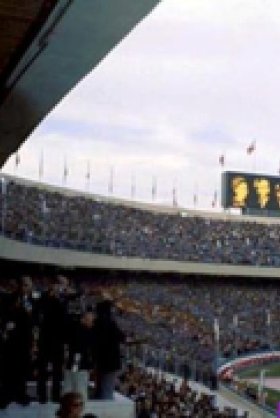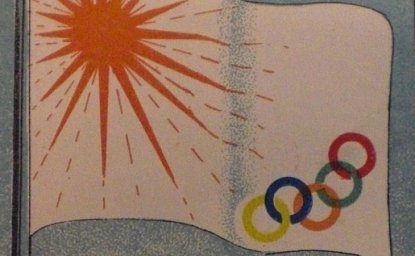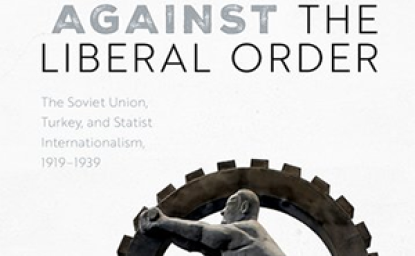Iranian Great Power Ambitions and China’s Return to the Olympic Movement, 1973-74



CWIHP eDossier No. 75
Iranian Great Power Ambitions and China’s Return to the Olympic Movement, 1973-74
Stefan Huebner
November 2016
“We want the true representation of Asia in the Asian Games Federation.”
The groundwork for the People’s Republic of China’s (PRC) return to the Olympics in 1980 was laid in the early 1970s through negotiations for its inclusion at the Seventh Asian Games in Tehran. Surprisingly, one of the PRC’s main allies in its return to international sports was the government of Iran, which hoped the PRC’s increasing influence in international politics would serve as a political counterbalance to the Soviet Union. This marked one of the very first forms of political cooperation between the PRC and Iran. It also paved the way for China to become a major power in the Olympic movement and the host of the 2008 Summer and 2022 Winter Olympics. Finally, China’s return mirrored the growing influence of a select number of Asian countries in global affairs, who were able to mobilize other Asian countries for their own (allegedly pan-Asian) agenda of overcoming the paternalistic behavior of mainly European controlled sports organizations.
The struggle for legitimacy between the PRC and the Republic of China (henceforth referred to as Taiwan) was directly connected to the two countries’ participation in international sporting events. Both claimed to be the sole representative of “China,” and were unwilling to participate in any event in which the other country was also taking part, since this would mean publically accepting the existence of two “Chinas.” In 1958, the PRC left the Olympic movement. The Cultural Revolution, beginning in 1966, resulted in its withdrawal from all of the remaining international sporting events in which it was involved. In 1973-74, however, when the Cultural Revolution started to calm down, PRC officials recreated ties with the International Olympic Committee (IOC) through the Asian Games. This regional sporting event was held under the patronage of the IOC, and the organizers of the Seventh Games (Tehran 1974) were closely associated with the Shah’s government, which was interested in cooperating with the PRC.
Image: Shah Mohammad Reza Pahlavi at the Inauguration of the 1974 Asian Games in Tehran.
Geopolitical shifts in several regions influenced the Iranian government’s plan to use the PRC to balance against the Soviet Union. In October 1971, the PRC took the seat of “China” in the United Nations, until then held by Taiwan. Only a few months earlier, in August, Iran diplomatically recognized the PRC, making cooperation between them significantly easier. The strong tensions that had emerged between the PRC and the USSR through the Sino-Soviet split eventually convinced the Iranian government that China could be used to limit the USSR’s freedom of action. At the same time, the United States’ influence was fading as it became focused on managing the conflict in Vietnam. This meant that the Iranians could not expect the immediate involvement of Washington in the Persian Gulf and the Indian Ocean, despite the Soviet Union’s increased interest in these regions in the early 1970s. The defeat of America’s ally Pakistan by India in 1971 further intensified Iranian feelings that its security policy needed to become increasingly self-reliant.
In 1969, an overstretched Britain announced its intent to permanently withdraw all of its troops based east of Suez. This decision heavily contributed to the decolonization process in the Persian Gulf, but also led the Iranian government to anticipate intensified Soviet involvement in the region, including Soviet arms transports to hostile Iraq. Consequently, the Iranians tried to take advantage of the United States’ distraction and its own increased leverage in Persian Gulf affairs to turn Iran into a great power. Iran used its growing oil revenues to fund massive arms purchases—from the United States in particular—supposedly to facilitate the defense of Iran’s major maritime oil trade routes. Simultaneously, the Iranian government promoted the idea of a neutral “Asian Union” encompassing the littoral states of the Indian Ocean that would serve security purposes, in this way communicating to both superpowers that they should limit themselves to their economic interests in the region. Intensifying cooperation with the PRC was a means to support this (ultimately unsuccessful) plan to dominate the Indian Ocean region and to limit the activities of the USSR. Furthermore, the Iranian government expected that better relations with the PRC would result in a reduction of Chinese support for communist groups in Oman and South Yemen.
In early 1972, the first Chinese-Iranian discussions concerning the PRC’s participation in the Seventh Asian Games began. Negotiations slowly intensified after Japan and the PRC normalized relations in September 1972, and the Japanese Olympic Committee subsequently became interested in bringing the PRC into the Asian Games. On August 7, 1973, the PRC’s All-China Sports Federation sent its application for participation in the Asian Games to Gholam-Reza Pahlavi, brother of the Shah, who served as president of the Iranian Olympic Committee and president of the Asian Games Federation (AGF) (Document 1). Just like at the United Nations, the PRC declared itself the sole representative of China, meaning that bringing it in and expelling Taiwan would be nothing but a change in credentials. Taiwan had taken part in the Asian Games since 1954, and unsurprisingly Taiwanese sports officials complained heavily about the PRC’s application and sought to present Taiwan as an independent country, which should be permitted to participate alongside the PRC in the Asian Games (Document 2). Despite this, AGF members from Iran and Japan filed a motion which accepted the terms of the PRC’s membership application, and it was approved at an AGF Executive Committee meeting on September 18, 1973 (Document 3). It is noteworthy that the Chinese-Iranian-Japanese collaborators regularly utilized pan-Asian rhetoric to legitimize their aims. In the case of the motion, the focus was on the size and population of China. It argued that “without the participation of the People’s Republic of China, the Asian Games Federation does not fully represent Asia.”
“Without the participation of the People’s Republic of China, the Asian Games Federation does not fully represent Asia.”
Similar pan-Asian claims were made during a debate on the topic at an AGF council meeting on November 16, 1973 by Hassan Rassouli, secretary-general of the organizing committee and director-general of the governmental Iranian Physical Education Organization. (Document 4). This second meeting, which all member countries (except Taiwan) were invited to attend, became necessary after several members pressured Pahlavi not to limit the decision on the PRC’s application to the small Executive Committee. During the meeting, Rassouli offered a pan-Asian discourse that members could use to publically legitimize their pro-PRC decision by claiming that they were fighting against Western (here, due to the composition of committees, mostly European) paternalism in sports affairs, which was itself a remnant of Western imperialism and colonialism. As a consequence, all members in favor of Taiwan’s continued membership were discursively denounced as cowards or as collaborators with paternalistic Western-dominated sports organizations. Rassouli referenced Africa and Latin America as examples of other regions under the patronizing influence of formerly influential European colonial powers. Should Asians, Latin Americans, and Africans unite—a common topos in non-aligned pan-Asian rhetoric, though difficult to realize in practice—they could break the remnants of European colonialism in international sports affairs:
But who are these bodies, who are these superlords, these great gnomes of sports sitting in Europe, these remnants of the old colonial policies of Europe dominating Asia, Africa, Latin America. Who are these self-imposed great personalities sitting and dictating to us what and how we should conduct the affairs of our own destiny… We, gentlemen, are masters of our destiny, and we have to decide what our destiny is going to be as far as sports in Asia is concerned without being dictated to by International Federations nor the International Olympic Committee.
The vote was taken openly after AGF president Pahlavi decided that a secret vote would not be appropriate, and the PRC’s application was approved. This resulted in Taiwan being expelled from the Asian Games until 1990. In February 7, 1974, the All-China Sports Federation held a meeting in preparation for the Seventh Asian Games (Document 5). A Xinhua News Agency press release on the meeting congratulated the AGF on its decision to expel the “Chiang Kai-shek clique,” and invited Taiwanese athletes to participate in the PRC’s team (which would indicate acceptance of the PRC’s control over Taiwanese sports affairs). Once again, pan-Asian rhetoric was used to justify the AGF’s decision: “[T]he meeting emphasized that the people of [A]sia are the masters of [A]sian affairs and any outside interference is intolerable to the people of [A]sia.”
International sports federations and the IOC eventually accepted the PRC’s participation in the Seventh Asian Games, held under the patronage of the IOC. Their decisions suggest that the pan-Asian rhetoric that surrounded China’s admission to the Asian Games was not completely hollow. This rhetoric emphasized and legitimized the growing influence of a select number of influential Asian countries in international sports, though hardly that of “Asia” as a whole. In the case of China, its acceptance into the Asian Games paved the way for its return to the Olympics in 1980 at the Winter Games in Lake Placid, as well as the lengthy negotiations which eventually admitted Taiwan under the compromise name of “Chinese Taipei.”
Document 1:
All-China Sports Federation Application for Chinese Membership in the Asian Games Federation (7 August 1973).
Source: H-FC02-ASIAN/002, The Olympic Studies Centre, Lausanne.
Document 2:
Taiwanese Response to the IOC Concerning the PRC’s Application, “Referring PRC’s Application [sic].”
Source: H-FC02-ASIAN/002, The Olympic Studies Centre, Lausanne.
Document 3:
Iranian-Japanese Motion to the Asian Games Federation on the Participation of the People's Republic of China (18 September 1973)
Source: H-FC02-ASIAN/002, The Olympic Studies Centre, Lausanne.
Document 4:
Speech to the Asian Games Federation Council by Hassan Rassouli, Secretary-General of the Iranian Organizing Committee (16 November, 1973)
Source: H-FC02-ASIAN/002, The Olympic Studies Centre, Lausanne.
Document 5:
Xinhua News Agency, "Decision of All-China Sports Federation on Participation in Seventh Asian Games”
Source: H-FC02-ASIAN/014, The Olympic Studies Centre, Lausanne.
Stefan Huebner is a Research Fellow at National University of Singapore’s Asia Research Institute. He is the author of Pan-Asian Sports and the Emergence of Modern Asia, 1913-1974, available via NUS Press and University of Chicago Press. He also spoke about the Pan-Asian Games on CWIHP's Sport in the Cold War podcast.
Author
Postdoctoral Research Fellow, Bundeswehr University Munich (Germany)

Cold War International History Project
The Cold War International History Project supports the full and prompt release of historical materials by governments on all sides of the Cold War. Read more


History and Public Policy Program
A leader in making key foreign policy records accessible and fostering informed scholarship, analysis, and discussion on international affairs, past and present. Read more

Explore More
Browse Insights & Analysis
Sport in the Cold War Podcast - The Pan-Asian Games


